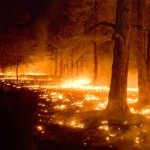 Many western states are prone to wildfires. Unfortunately, wildfires often spread to involve rural, suburban, and even urban communities. Landscaping, however, can play a huge role in reducing the threat that wildfires pose to a structure. It may involve moving trees, shrubs and plants as well as choosing plants that are pleasing to your client and fire resistant. The Napa Communities Firewise Foundation advocates for a four-zone approach to landscaping that is designed to create a “defensible space” against wildfires.
Many western states are prone to wildfires. Unfortunately, wildfires often spread to involve rural, suburban, and even urban communities. Landscaping, however, can play a huge role in reducing the threat that wildfires pose to a structure. It may involve moving trees, shrubs and plants as well as choosing plants that are pleasing to your client and fire resistant. The Napa Communities Firewise Foundation advocates for a four-zone approach to landscaping that is designed to create a “defensible space” against wildfires.
Zone 1
10 Feet
The “structure ignition zone” extends 10 feet from a structure and should contain only high-moisture, drought-tolerant plants. Succulents are a great choice for zone 1 as are rocks and compost rather than bark mulch. Plants in zone 1 should be quite short, widely spaced, and watered regularly.
Zone 2
10-30 Feet
The “firebreak zone” should reduce the intensity of a blaze and deprive it of fuel. It is a good idea to use fire-resistant plants in this area and to keep branches and foliage pruned at least 6 feet off of the ground. Low plants should never be placed under taller plants as they provide a “ladder” for fire to climb. If grass is desired, zone 2 is the place to plant a drought-tolerant variety. Well-maintained grass is a good deterrent against fire.
Zone 3
30-100 Feet
The “reduced fuel zone” is the most important of the four. Its purpose to reduce heat and flame reach of a wildfire. All yard waste should be removed from this zone and plants should be widely spaced (>30 feet between clusters). Large trees are appropriate for zone 3.
Avoid high-oil plants in zone 3 and stay away from evergreens. Evergreens tend to be highly flammable because
- They don’t contain as much moisture as deciduous plants, particularly during dry summers when fires are more common;
- They retain more dead, dry branches and “duff” than deciduous plants; and
- They have a high sap content.
If evergreens remain, they must be pruned to remove dry debris and twigs. Needles are high in oil and pruning branches to at least 12 feet off of the ground will reduce fire risk. As a general rule, the more fragrant a plant is (excepting flowers), the more volatile it will be.
Zone 4
100+ Feet
The final zone is called the “access zone” and should be designed to give emergency access to the structure and provide several safe escape routes. There should be nothing flammable within 10 feet of ingress and egress routes and there should be at least 14 feet of clearance over any space that emergency vehicles might access.
Resources
www.napafirewise.org
http://www.firefree.org/images/uploads/FIR_FireResPlants_07.pdf

